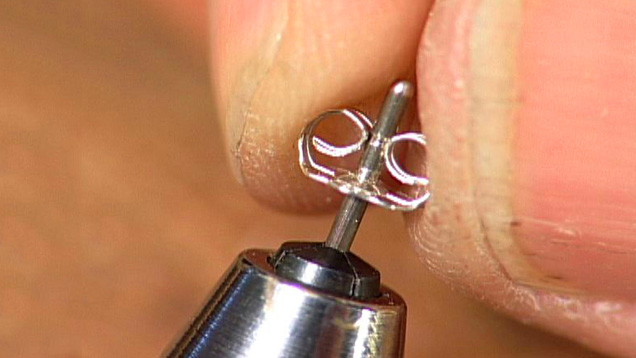Bench Tip #4: How To Adjust Earring Backs
Adjusting earring backs
There are many types of backs available to hold earrings securely in place. Clutch, friction or butterfly backs are discs with curled-up tabs that oppose one another, acting as springs that pinch the ear post. The post has notches on it that function as stops so the clutch backs can hold the earring in place. Adjusting the tension of these springs so the earrings fit comfortably and securely is a routine service task for the bench jeweler.Loosening the tension in the curled springs reduces the friction on the post but makes the catch less distinct, posing a very real risk of losing the earring. Tightening the curled springs, on the other hand, increases the friction on the post and gives the catch a better connection. But this can make it uncomfortable, even painful, for your customer to put on and take off the earrings.
Simply deepening the grooves on the ear post also has limitations, because the post is weakened without a noticeable effect on the catch. The curled springs bridge the notches, leaving a barely noticeable stop.
Here is a better way to tighten earring springs. First, you need to make the curvature of the springs smaller at the point of contact with the post. This allows the curls to sink deeper into the notches and create a more secure catch. Mark this point of contact on the outside thickness of the clutch back with a marker. Next, open the curled springs to the point where they can be grasped with the appropriate pair of pliers and give each spring a little extra curl at the mark you made. Then restore the original curvature to the remainder of the spring, adjusting for the desired tension as you go. In many cases, this sufficiently enhances the hold of the catch.
This may not be tight enough for some, so use a 1.0 to 1.3 mm ball burr to make miniscule indents in the curled springs of the clutch back. This will enable them to sink even deeper into the ear post notches and make the catch considerably more pronounced. Working from the top of the clutch back, simultaneously rest the ball burr on both springs as you cut a tiny indent dead center. Repeat this step from below the connection with the ear post. You will likely have to pinch the shaft of the burr between the curled springs and pull back on the burr to avoid excessive widening of the hole in the disc.

A close-up of the earring post and back shows how the back catches in the grooves of the post.
Bear in mind that commercially available clutch backs can be less than 0.2 mm thick, so it takes little to burr right through them. But very small indents can create secure stops that are safer than even the strongest possible tension between the curled springs. If properly positioned, these indents should stabilize the position of the clutch back on the post.



